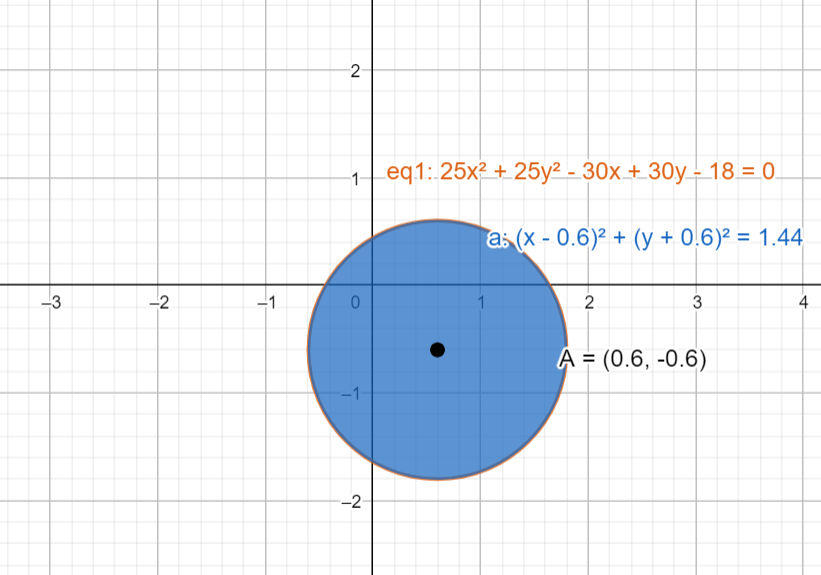
How do you decide whether or not the equation below has a circle as its graph? If it does, give the centre and the radius. If it does not, describe the graph ~$25x^{2} +25y^{2} -30x+30y-18=0$?
Answer
514.8k+ views
Hint: This given question is based on the equation of the circle. Before solving this, we need to know what the equation of circle? When an arc is drawn from a fixed point, it is called the centre, all points on the curve have the same distance from the centre point of the centre, then a circle is formed. If a circle has a centre and radius, then it will have a graph. Let us solve the problem.
Complete step-by-step answer:
The general form of the equation of any type of circle is represented as
\[ax^{2} +2hxy+by^{2} +2gx+2fx+c=0.................(i)\]
Equation(i) represents the CIRCLE. Only if,
\[(i)a=b\ne 0 (ii)g^{2} +f^{2} -ac>0 \& (iii)h=0\]
So, in this event, its centre $\left(\dfrac{-g}{a} ,\dfrac{-f}{a} \right)$ and radius is $\dfrac{\sqrt{g^{2} +f^{2} -ac} }{\left|a\right|} $
Let consider the given equation of the circle,
\[25x^{2} +25y^{2} -30x+30y-18=0................(ii)\]
In the question, they asked to decide whether the given equation has a circle or not as its graph. To decide whether the given equation has a circle or not, we should compare equation(ii) with equation (i), then we get;
\[a=25=b\ne 0;\]
\[h=0;\]
\[2g=-30\Rightarrow g=-15;\]
\[2f=30\Rightarrow f=15;\]
\[c=-18;\]
Equation (ii) has a circle, now let’s find out its centre and its radius,
Substitute the corresponding values in the formulae
Centre is \[\left( \dfrac{-g}{a},\dfrac{-f}{a} \right)\]
\[\Rightarrow \] \[\left( \dfrac{-(-15)}{25},\dfrac{-15}{25} \right)=\left( \dfrac{3}{5},\dfrac{-3}{5} \right)\]
Radius =\[\dfrac{\sqrt{{{g}^{2}}+{{f}^{2}}-ac}}{\left| a \right|}\]\[\Rightarrow \]\[\dfrac{\sqrt{{{(-15)}^{2}}+{{(15)}^{2}}-(25)(-18)}}{\left| 25 \right|}\]
\[\Rightarrow \dfrac{\sqrt{900}}{25}=\dfrac{30}{25}=\dfrac{6}{5}\]
Putting all together,
\[25x^{2} +25y^{2} -30x+30y-18=0\]
We have centre as $\left(\dfrac{3}{5} ,\dfrac{-3}{5} \right)$ and radius as $\left(\dfrac{6}{5} \right)$
This is a circle.
Then it will have a graph.
‘Eq1’ represents given equation of the circle
‘A’ represents the centre of the circle (black dot).

Note: We have alternate method for finding given equation is a circle or not as its graph, i.e., standard form for the equation of the circle
\[\left(x-h\right) ^{2} +\left(y-k\right)^{2} =a^{2} ...............................(iii)\]
Where (h, k) is the centre and ‘a’ is the radius.
Blue region in the graph depicts the equation (iii) form
Complete step-by-step answer:
The general form of the equation of any type of circle is represented as
\[ax^{2} +2hxy+by^{2} +2gx+2fx+c=0.................(i)\]
Equation(i) represents the CIRCLE. Only if,
\[(i)a=b\ne 0 (ii)g^{2} +f^{2} -ac>0 \& (iii)h=0\]
So, in this event, its centre $\left(\dfrac{-g}{a} ,\dfrac{-f}{a} \right)$ and radius is $\dfrac{\sqrt{g^{2} +f^{2} -ac} }{\left|a\right|} $
Let consider the given equation of the circle,
\[25x^{2} +25y^{2} -30x+30y-18=0................(ii)\]
In the question, they asked to decide whether the given equation has a circle or not as its graph. To decide whether the given equation has a circle or not, we should compare equation(ii) with equation (i), then we get;
\[a=25=b\ne 0;\]
\[h=0;\]
\[2g=-30\Rightarrow g=-15;\]
\[2f=30\Rightarrow f=15;\]
\[c=-18;\]
Equation (ii) has a circle, now let’s find out its centre and its radius,
Substitute the corresponding values in the formulae
Centre is \[\left( \dfrac{-g}{a},\dfrac{-f}{a} \right)\]
\[\Rightarrow \] \[\left( \dfrac{-(-15)}{25},\dfrac{-15}{25} \right)=\left( \dfrac{3}{5},\dfrac{-3}{5} \right)\]
Radius =\[\dfrac{\sqrt{{{g}^{2}}+{{f}^{2}}-ac}}{\left| a \right|}\]\[\Rightarrow \]\[\dfrac{\sqrt{{{(-15)}^{2}}+{{(15)}^{2}}-(25)(-18)}}{\left| 25 \right|}\]
\[\Rightarrow \dfrac{\sqrt{900}}{25}=\dfrac{30}{25}=\dfrac{6}{5}\]
Putting all together,
\[25x^{2} +25y^{2} -30x+30y-18=0\]
We have centre as $\left(\dfrac{3}{5} ,\dfrac{-3}{5} \right)$ and radius as $\left(\dfrac{6}{5} \right)$
This is a circle.
Then it will have a graph.
‘Eq1’ represents given equation of the circle
‘A’ represents the centre of the circle (black dot).

Note: We have alternate method for finding given equation is a circle or not as its graph, i.e., standard form for the equation of the circle
\[\left(x-h\right) ^{2} +\left(y-k\right)^{2} =a^{2} ...............................(iii)\]
Where (h, k) is the centre and ‘a’ is the radius.
Blue region in the graph depicts the equation (iii) form
Recently Updated Pages
Master Class 12 Economics: Engaging Questions & Answers for Success

Master Class 12 Maths: Engaging Questions & Answers for Success

Master Class 12 Biology: Engaging Questions & Answers for Success

Master Class 12 Physics: Engaging Questions & Answers for Success

Master Class 8 Maths: Engaging Questions & Answers for Success

Class 8 Question and Answer - Your Ultimate Solutions Guide

Trending doubts
What is meant by exothermic and endothermic reactions class 11 chemistry CBSE

10 examples of friction in our daily life

One Metric ton is equal to kg A 10000 B 1000 C 100 class 11 physics CBSE

1 Quintal is equal to a 110 kg b 10 kg c 100kg d 1000 class 11 physics CBSE

Difference Between Prokaryotic Cells and Eukaryotic Cells

What are Quantum numbers Explain the quantum number class 11 chemistry CBSE




